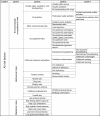Improving and Expanding Estimates of the Global Burden of Disease Due to Environmental Health Risk Factors
- PMID: 31626566
- PMCID: PMC6867191
- DOI: 10.1289/EHP5496
Improving and Expanding Estimates of the Global Burden of Disease Due to Environmental Health Risk Factors
Abstract
Background: The Global Burden of Disease (GBD) study, coordinated by the Institute for Health Metrics and Evaluation (IHME), produces influential, data-driven estimates of the burden of disease and premature death due to major risk factors. Expanded quantification of disease due to environmental health (EH) risk factors, including climate change, will enhance accuracy of GBD estimates, which will contribute to developing cost-effective policies that promote prevention and achieving Sustainable Development Goals.
Objectives: We review key aspects of the GBD for the EH community and introduce the Global Burden of Disease-Pollution and Health Initiative (GBD-PHI), which aims to work with IHME and the GBD study to improve estimates of disease burden attributable to EH risk factors and to develop an innovative approach to estimating climate-related disease burden-both current and projected.
Methods: We discuss strategies for improving GBD quantification of specific EH risk factors, including air pollution, lead, and climate change. We highlight key methodological challenges, including new EH risk factors, notably evidence rating and global exposure assessment.
Discussion: A number of issues present challenges to the scope and accuracy of current GBD estimates for EH risk factors. For air pollution, minimal data exist on the exposure-risk relationships associated with high levels of pollution; epidemiological studies in high pollution regions should be a research priority. For lead, the GBD's current methods do not fully account for lead's impact on neurodevelopment; innovative methods to account for subclinical effects are needed. Decisions on inclusion of additional EH risk-outcome pairs need to be guided by findings of systematic reviews, the size of exposed populations, feasibility of global exposure estimates, and predicted trends in exposures and diseases. Neurotoxicants, endocrine-disrupting chemicals, and climate-related factors should be high priorities for incorporation into upcoming iterations of the GBD study. Enhancing the scope and methods will improve the GBD's estimates and better guide prevention policy. https://doi.org/10.1289/EHP5496.
Figures
References
-
- Achakulwisut P, Mickley LJ, Anenberg SC. 2018. Drought-sensitivity of fine dust in the US Southwest: implications for air quality and public health under future climate change. Environ Res Lett 13(5):054025, 10.1088/1748-9326/aabf20. - DOI
-
- Amato MS, Moore CF, Magzamen S, Imm P, Havlena JA, Anderson HA, et al. 2012. Lead exposure and educational proficiency: moderate lead exposure and educational proficiency on end-of-grade examinations. Ann Epidemiol 22(10):738–743, PMID: 22902043, 10.1016/j.annepidem.2012.07.004. - DOI - PMC - PubMed
Publication types
MeSH terms
Grants and funding
LinkOut - more resources
Full Text Sources
Medical



